San Francisco and My Commute
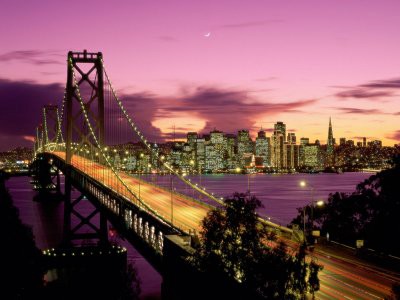
In this post, I’m going to write a lot of things about commuting and transportation. I feel that I should first make a disclaimer that I’m not a city planner, transportation engineer or anything remotely close, so I could be wrong on many levels. I’m just a software programmer making observations in my daily life.
Writing code is my job and has been so for the past 9 years professionally, and probably 16 years or so in total. I love tech and working in it. I also love food. While I personally know people (in tech, too) who want to save time and money and never have to worry about food again, I’m not one of these people. I’m serious about getting good eats, whether it’s attempts to cook on my own or finding and enjoying restaurants. That’s what makes the San Francisco Bay Area special and why I want to live here (in addition to the fact that I grew up here) — it provides both tech jobs and good food.
Still, there are a number of things one might not like about the SF Bay Area. At the top of this list, at least for me, is the commute. I live in the East Bay, and commute into SF for work. This in itself is a topic for discussion, which I’ll go through briefly. However what I really want to talk about will be some hard problems about commutes in Bay Area which I’ve thought long about and have not come up with any reasonable solution, so perhaps experts at this matter or those in power could consider this a call for help.
Why the SF / East Bay commute?
First, we can go over what the reasons are that one might choose to live in SF, and what I think about them. 1) The easiest and most straightforward is that assuming you work in SF, you can be close to work. 2) Then, there is the fact that SF is hip and a lot of nightlife activities are available. 3) It’s also got an abundance of food options. 4) Weekend activities choices are endless.
Here are my thoughts about each of those:
For work location, unless you live within walking distance to your work, chances are your commute won’t be a lot shorter compared to living outside the city. Public transportation is often not fast unless you have the ideal conditions. (home and office both < 5-minute walk from a Bart station within the city, for example) Driving in from outside the city (East Bay, Peninsula, etc.) could often take shorter time than taking Bart, if you don’t work strict hours like the financial district folks. (good chance for that if you’re in tech)
I feel that I’m past the age of enjoying nightlife activities and wanting to have city vibes. When I was a fresh grad from college, I worked in Folsom, CA at a big computer chip company for a while and lived in the suburban city of Fair Oaks, CA. I really, really wished to live and work in a city like SF during that time, to feel like a city person and feel young. Not so much now — I’d much rather spend time either with family and friends or just by myself reading a book, playing a video game, etc. at night; or more likely, just going to bed early to stay healthy.
SF does have a lot of great food options, I can’t argue with that. However, so do a lot of other cities in Bay Area. As an Asian, I enjoy a lot of Asian food. I would actually say there are just as much, if not more, quality Asian food choices outside of SF. East Bay (particularly, the Union City and Fremont area, where I live) has an abundance of great Asian food. True, there are better fancy burgers and fancy pizzas in the city, but I can get those while I’m there for work.
Like the second point, on weekends I tend to spend time with family and friends first and foremost. What I do with them exactly, matter a little less to me. A day spent at a friend’s house playing board games is just as much fun (if not more so) to me than heading to a music festival in Golden Gate Park or Treasure Island. Having options of recreational activities is just not an important enough factor for me to decide where I want to live.
Adding all those up together, along with the trump card — the premium housing costs in San Francisco, it makes just about zero sense for me to live in SF. East Bay has a perfect balance of price and good food, and on top of that, for me, proximity to my friends and family. It’s really a no-brainer for me. (As a side note, I would be extremely happy if tech startups move away from the default option of locating in SF, and just move south to the suburban cities, to help with house prices and gentrification issues. I wouldn’t have to make such commutes anymore, too.)
Now that we got that out of the way, I’ll get to what I actually want to talk about, the commute.
The problems of commuting in Bay Area
To understand the core problems that commuters face in the Bay Area, first we need to look at the geography. This is what the Bay Area looks like.
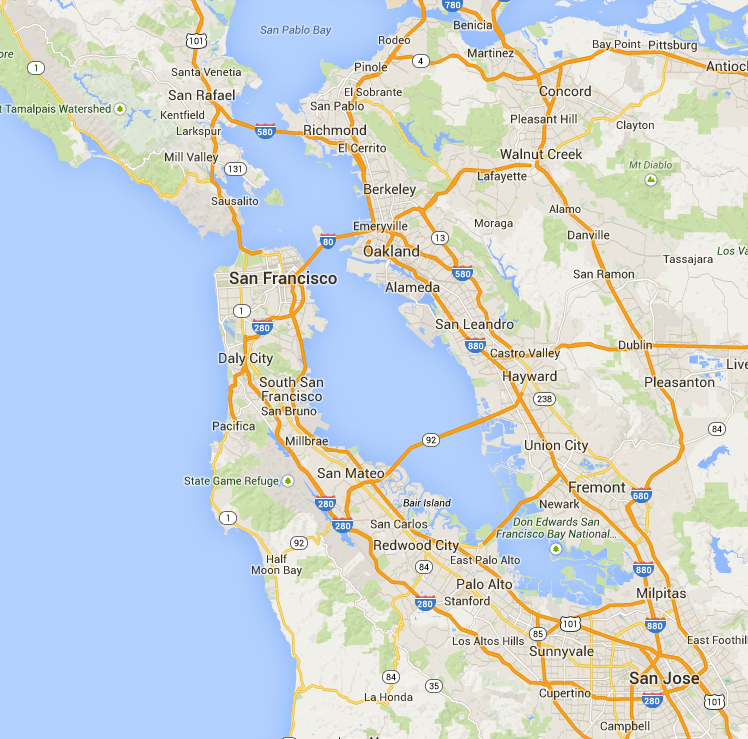
It’s easy to see the deeply connected cities (you could call them urban parts of this region) and think of them all as one inter-connected metropolitan area (with some areas being more urban and some less). It’s easy to think of this as one geographical region of population; and it’s easy to consider living anywhere in this region and working anywhere in this region. (the most popular combination being working in SF, and living in any of the surrounding cities)
Surely, some facts do confirm that. When traffic is light, it takes 35 minutes to drive from Union City to Downtown SF — a reasonable commute time. It gives people the idea that it is a reasonable choice of place to live if your job is in Downtown SF. (and it is indeed so under the ideal conditions; like if you have a job that doesn’t require you to commute peak hours, or if both your house and office are directly next to a Bart station) So why is it a problem?
The thing is, San Francisco Bay Area is actually geographically large, compared to other metropolitan areas. Unfortunately, for majority of the people who choose the combination of working in SF and living in one of the surrounding cities, the conditions are not so ideal. For example, most people who work office jobs in SF are indeed required to commute somewhat near peak times, for those who drive. And for those who take the train, 99% of houses in an East Bay city are not less than a 5-minute walk from a Bart station.
Driving into SF has just a host of obvious problems that I won’t cover too much about because everyone knows them too well: In peak hours the time of a route doubles; Giants, 49ers, GS Warriors, A’s and Raiders game in various times of the day and year all cause traffic deadlocks in various areas of the Bay; long drives increase chances of accidents which in turn cause more traffic. They’re all reasons we’re all too familiar with. The public transportation is more often the subject of a debate or discussion, and I’d like to focus there as well.
In most metropolitan cities, people live far away from work and take public transportation into office. What’s wrong with doing that in the Bay Area?
And this is why the geography matters. Let’s compare the size of the Bay Area to a couple of other metropolitan areas in the world.
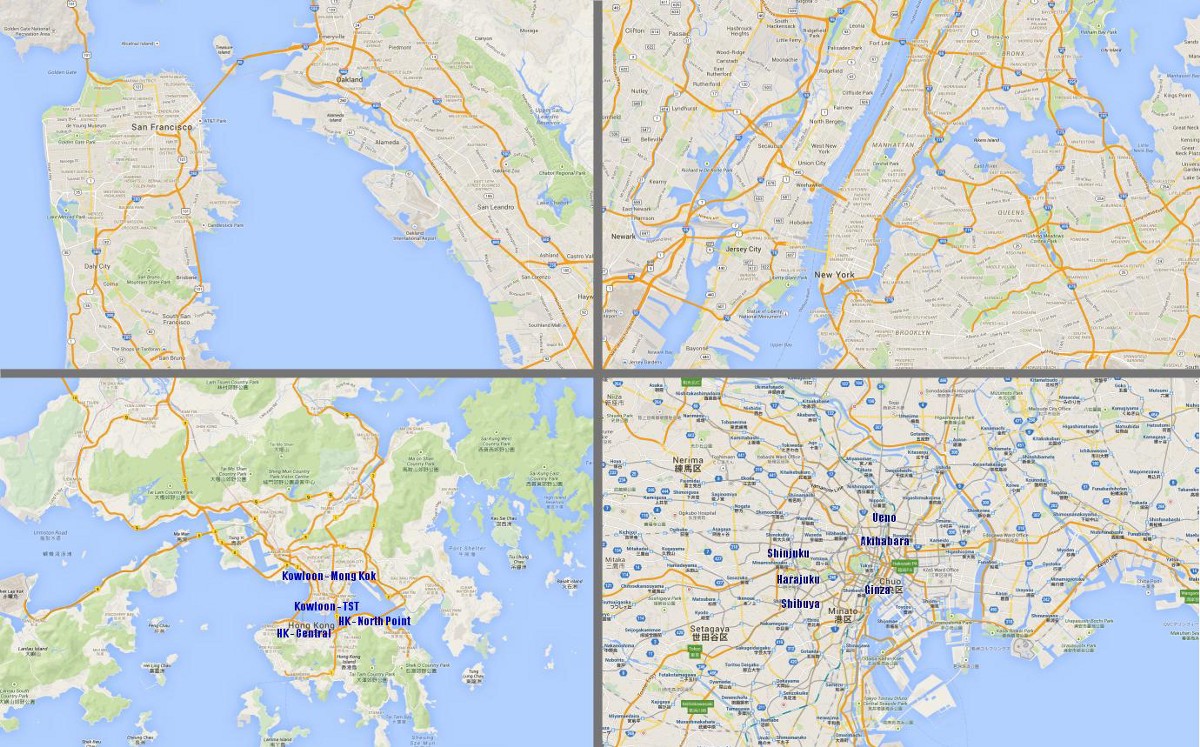
The maps above are all under the same zoom-level in Google Maps. This means they are roughly about the same scale. (Google Maps, the source of my map images here, uses the Mercator map projection style — at least a very close variation of it. What that means is the closer a location is to the north/south poles, the more stretched out they appear. So Hong Kong for example appears a little bit “smaller” than it really should be, when compared to New York; while SF and Tokyo are pretty close. However, it’s not a huge difference, and is negligible for the purpose of this discussion.)
I’ve picked a few cities that I’m relatively familiar with as examples (I was born in Hong Kong; and I’ve visited New York, NY and Tokyo, Japan in recent years; and traveled around all these areas extensively and taken plenty of public transportation). They are all examples of cities with great public transportation options.
For those not familiar with Hong Kong and Tokyo, I labeled a few key areas where one might typically travel between (such as working in one of those areas and living in another one of those).
The point here is that the Bay Area is actually huge and most people usually don’t think about it this way. In roughly the same dimensions, you can see the entirety of Hong Kong SAR, the Greater Tokyo area, the Greater NY area, and about… a quarter of the Bay Area. You can barely see even just Hayward!
What that means is that public trains in other metropolitan cities really cover a lot less ground, literally, as far as a width-by-height box-area goes, compared to the SF Bay Area. (of course, they cover a lot more ground in terms of density of train lines within their smaller box-areas.) This answers several issues people usually question about Bart and why train services in Bay Area are so abysmal:
- Why does it take so long to ride Bart from East Bay into SF?
Because there’s just a lot of distance to cover, even if the trains are just as fast as other metropolitan trains. - Why are Bart trains so infrequent? (Typical wait time for a train from Fremont to Downtown SF is about 15 minutes, even at peak hours, for example.)
Because any more frequent trains from different directions in the East Bay would cause collisions when they all get into Downtown SF, which already sees a train every few minutes. One could argue for multiple levels of platforms in Downtown SF, but adding more trains over on the East Bay side is still problematic by the fact that there is literally only 1 track through each direction at many given points throughout the East Bay. - Why are Bart stations so spread-out?
You would need tons more stations spread over in every little neighborhood in each suburban city to cover enough areas such that most people can walk to train stations — building such tracks would be impossible by now considering all the existing houses and neighborhoods already there.
Of course, there’s also the problem that Bart doesn’t reach very many places at all even inside the city. If you don’t work within 5 to 10-minute walking distance from a Bart station in SF, chances are you’ll need to change transportation when you get in, which makes the commute time even longer and more unsustainable. SF is huge, and less than 5% of the city is reasonably walkable from a Bart station.
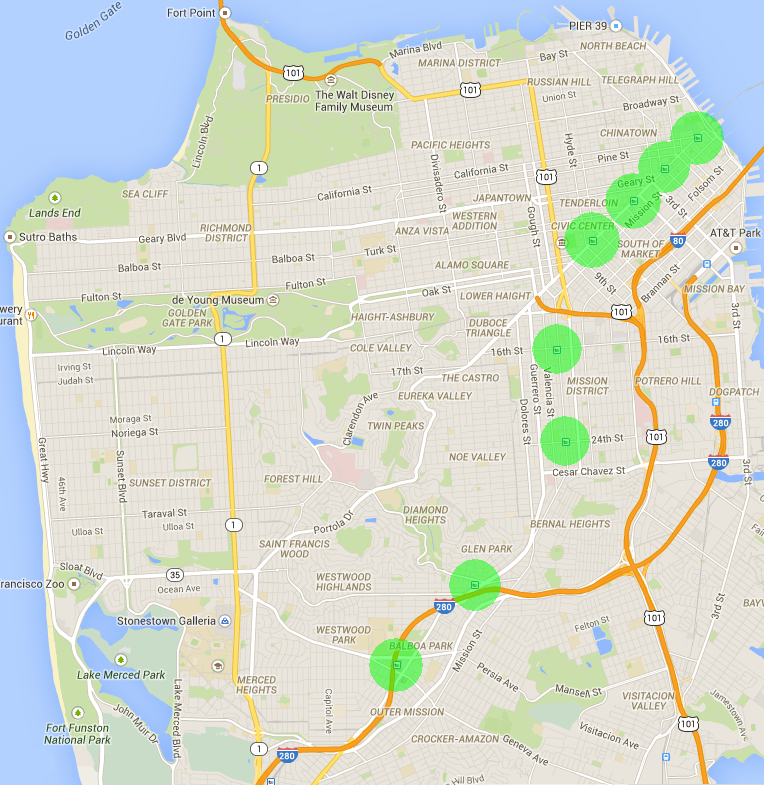
When Bart tried to develop lines in the city, people had voted against it successfully and/or cost problems stopped them. You could say that we’re paying the price now, but frankly I’m not sure if they’ll help very much even if the development passed approvals and we did have Bart lines going through Sunset, Richmond districts, and well into the other side of the Golden Gate Bridge. All the other problems together are just too much for one train system to solve. Subway train systems work very well for dense cities — San Francisco (and the larger Bay Area) is just not dense enough.
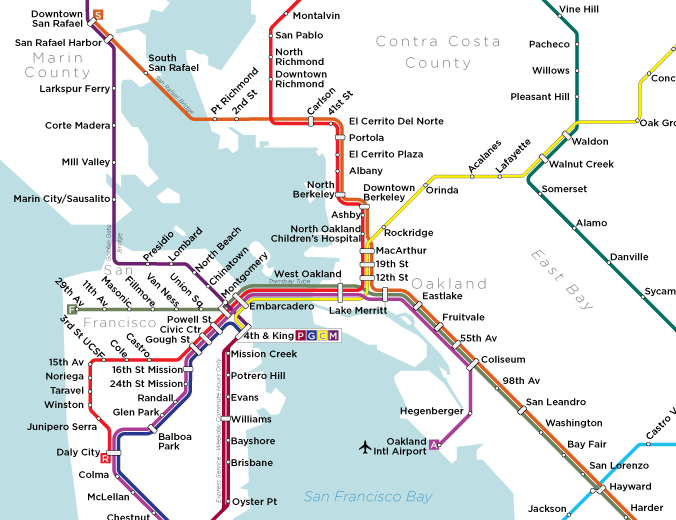
Overall, San Francisco is trying very hard to behave like other metropolitan regions of the world like New York (Manhattan), Hong Kong and Tokyo, when it comes to giving people options of where to live and how to get to work. However it seems geographically unfeasible or simply too difficult to make it work practically.
As an end note for all of this — commutes of over 30 minutes are detrimental to your mental health and emotions/happiness. Short commutes are proven to increase population happiness, as seen in Bogotá, Colombia. According to psychology professor Daniel Gilbert at Harvard University, “You can’t adapt to commuting, because it’s entirely unpredictable. Driving in traffic is a different kind of hell every day.” The San Francisco Bay Area is definitely not doing very well at solving this problem. As Silicon Valley technologists who attempt to solve real world social problems, what might some of our suggestions be at tackling this?




